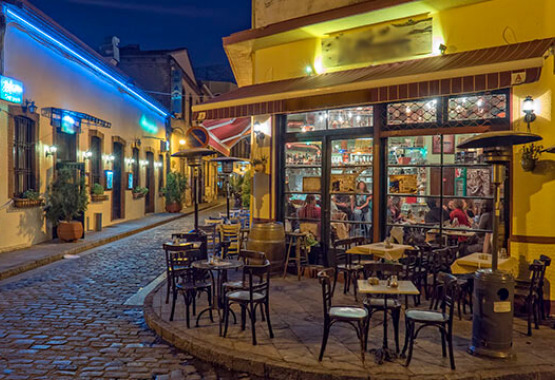
Maritime Museums
5000 years of history
The Greeks’ natural affinity with the sea has remained strong across the millennia; this multifaceted and long relationship is shown, and parts of it are highlighted, in maritime and naval museums throughout the country. Begin your journey to Greece’s fascinating maritime history by visiting the Hellenic Maritime Museum, in Marina Zeas area, Piraeus. See works of art by great marine painters, like Volanakis, and learn about the seafaring adventures of Greeks across the ages, from prehistoric times to the present day, through a variety of objects, as well as a collection of maps dating to the 16th century.A trip to a marine theme park is our next suggestion. The Park of Maritime Tradition in Floisvos, is in Palaio Faliro, Athens: see historic Greek vessels, such as ‘Olympias’, a unique replica of an ancient Greek trireme [an ancient Greek warship]; and ‘Thales of Miletus’, a cable-laying steamship built in the USA in 1909; Go aboard the destroyer ‘Velos’ (now a museum of the resistance against the 1967 Greek Junta); and the battleship ‘Averof’ which is now a museum ship.
The Greek islands are homelands of generations of sea captains, mariners, and worldwide famous shipowners and magnates. Follow us on a tour to maritime museums across the country and find out more about the Greek naval history and marine life.
Chios Maritime Museum shows aspects of the island’s naval history, and places emphasis on the period starting from World War II. The nearby island of Oinousses also has a long history, the course of which has been shaped in connection with that of Chios Island. Visit the Oinousses Maritime Museum where you will see ships dating to Napoleon’s times, built by French prisoners in England, 18th and 19th c. travel and combat rifles as well as newer ship models. If you take a trip to the Cyclades, your list of must-visit places should include the beautiful maritime museums on Santorini, Mykonos, Andros and Milos Islands.
Tour the Maritime Museum of Oia, on Santorini Island. See drawings of local shipyards, figureheads, carved sea chests, rare documents, maps, charters, dowry contract documents, wills, sextants and various small items of daily use on old sailboats. Visit the Aegean Maritime Museum on Mykonos Island. You will be impressed by exhibits such as models of ships that sailed the seas from the Stone Age until the early 20th century, historic nautical documents, rare engravings and maps, ancient items, navigational instruments and coins with maritime themes dating from the 5th c. BC to the 5th c. AD, as well as 5000 or so rare books.
Take a trip to Andros Island and visit the Maritime Museum on Chora. You will see an impressive collection of ship registers, nautical training manuscripts, uniforms, navigational instruments, and other items donated by local shipowners. Take your pictures by the monument of the Unknown Sailor in the square, with the Maritime Museum in the background.
Your next option is a visit to the Maritime Museum on Milos Island. It’s located by Adamantas harbour where you will see a wooden boat named Eirini, built in the traditional Cycladic boat building style. Exhibits include items from prehistoric times, obsidian tools, finds that date from the 480BC naval battle of Salamina (between the Greeks and the Persians) and other more recent objects.
If you choose an Ionian Sea island for your holidays, pick one (or more) with a maritime museum. On Zante (or Zakynthos) Island you can visit the Maritime and Historical Museum, in Bochali area: see the maritime art paintings on display, the miniature models of ships and the variety of nautical instruments. The Milanio Maritime Museum is in Tsilivi area and it owns impressive collections of paintings and photos, uniforms, models of ships, swords, medals compasses, coats of arms etc.
Head north to Ithaca Island and visit the Maritime & Folklore Museum; you will impressed by J.H.W. Tischbrein’s copper engravings with figures from Homer’s epic poems as well as from the collection of local folk art exhibits.
Travel to Corfu, the northernmost Ionian Sea Island, and take a trip to Benitses (at a 12km distance from Corfu town). In the Corfu Shell Museum you will see collections of shells, fossils, sponges, corals and embalmed fish from the Mediterranean Sea as well as the Indian and Pacific Oceans.
Next, take a tour around Crete and learn about its fascinating maritime history that dates to the dawn of civilisation. Visit the Maritime Museum located in Firka Fortress, Chania town. You will admire the numerous exhibits dating from the island’s Venetian period to the post WWII period. Greece is a seafaring nation. The maritime traditions are an important part of life not only on the islands but on coastal areas of the mainland too. The maritime museums across the country honour this heritage and welcome visitors who wish to explore their treasures on display.
The Maritime Museum of Galaxidi, in Galaxidi town, Fokida, Central Greece, owns one of the biggest collections of navigational instruments in the country, as well as figureheads, paintings, weapons and heirlooms dating to the period of the Greek War of Independence (1821). One of the museum’s most important exhibits is the “Chronicle of Galaxidi”, a manuscript describing the town’s history over a period of nine centuries (10th – 18th incl.).
The ancient Neapolis town (modern day Kavala town, Macedonia) is where the first shipyards were built on the North Aegean Sea shores, using timber from nearby Thasos Island. Visit the Maritime Museum of Kavala where, among other exhibits, you will see three traditional boats built according to the local shipbuilding traditionς or Litochoro town, Pieria Region, Central Macedonia, where you can take a tour of the local Maritime Museum. See boats, nautical tools and rare objects as well as other material connected with the area’s intangible maritime cultural heritage (traditions, customs, way of life, songs).
Our list of suggestions ends with a trip to Skiathos Island, where you can take a tour of the local Maritime and Culture Tradition Museum, located at the Cultural Community Centre of “Bourtzi”. Explore through its exhibits, the maritime and naval tradition of the most cosmopolitan island in the Northern Sporades.
Enjoy the joyride, wherever you choose to go!




